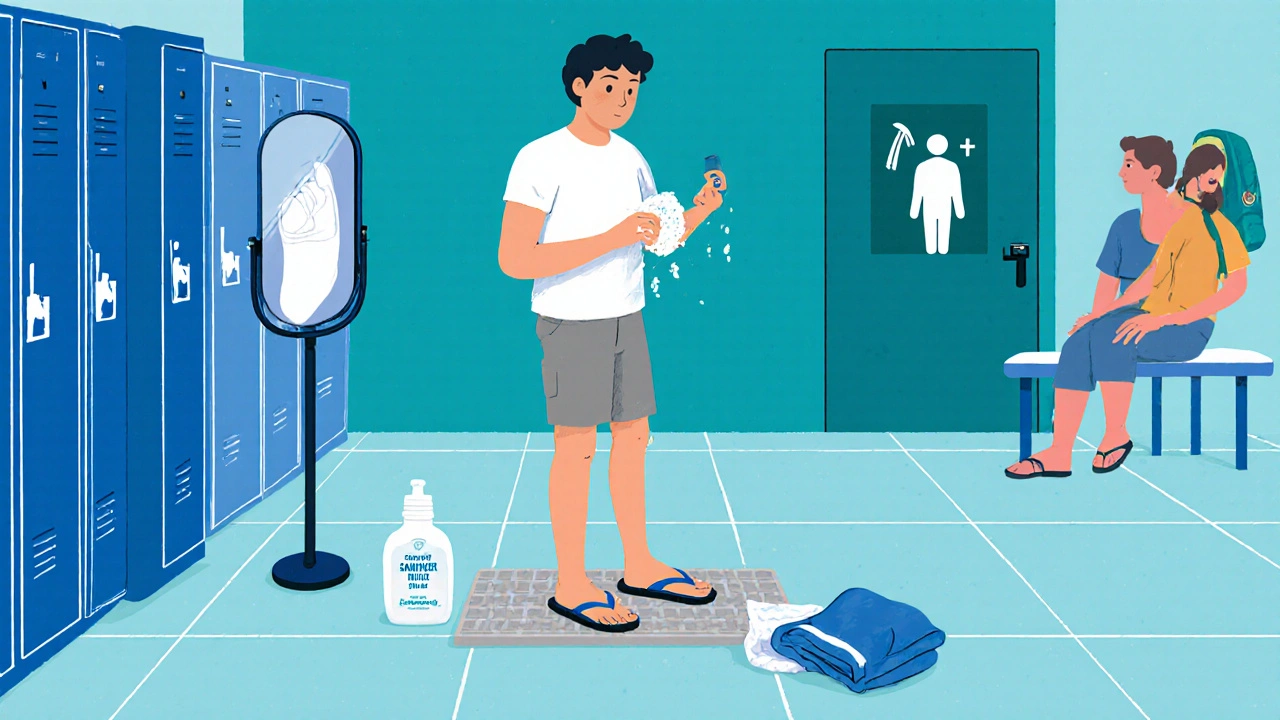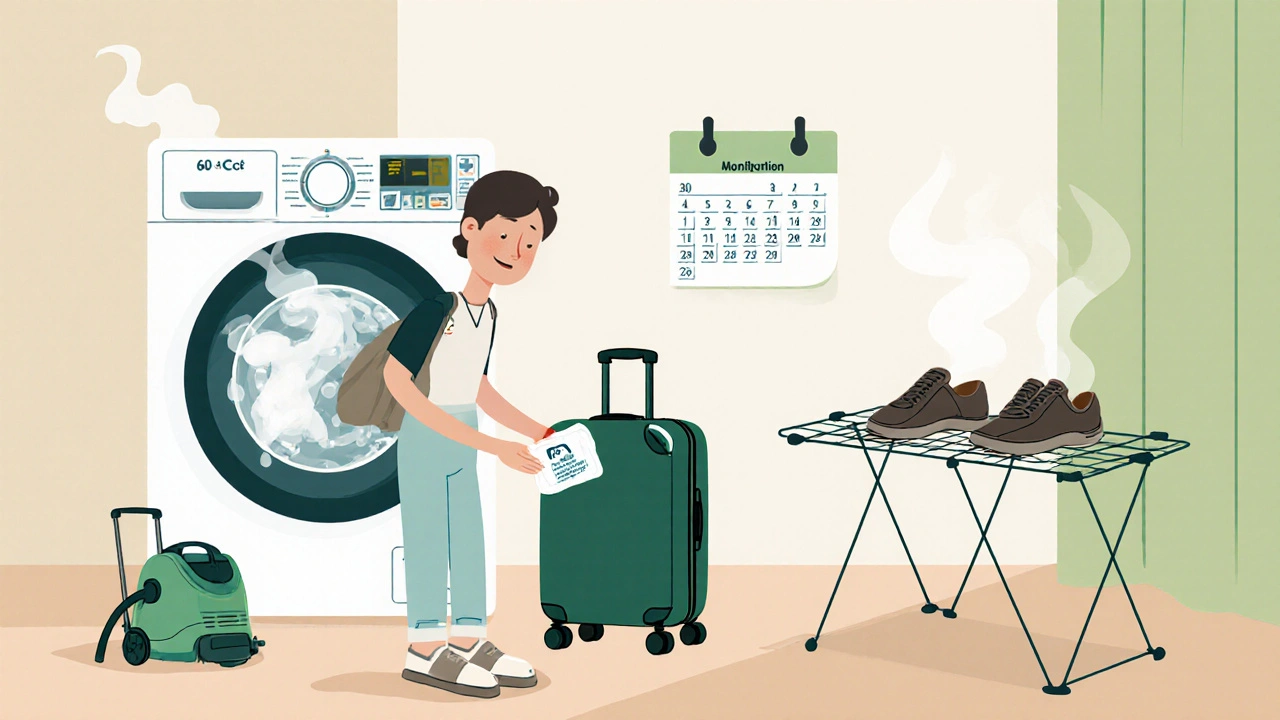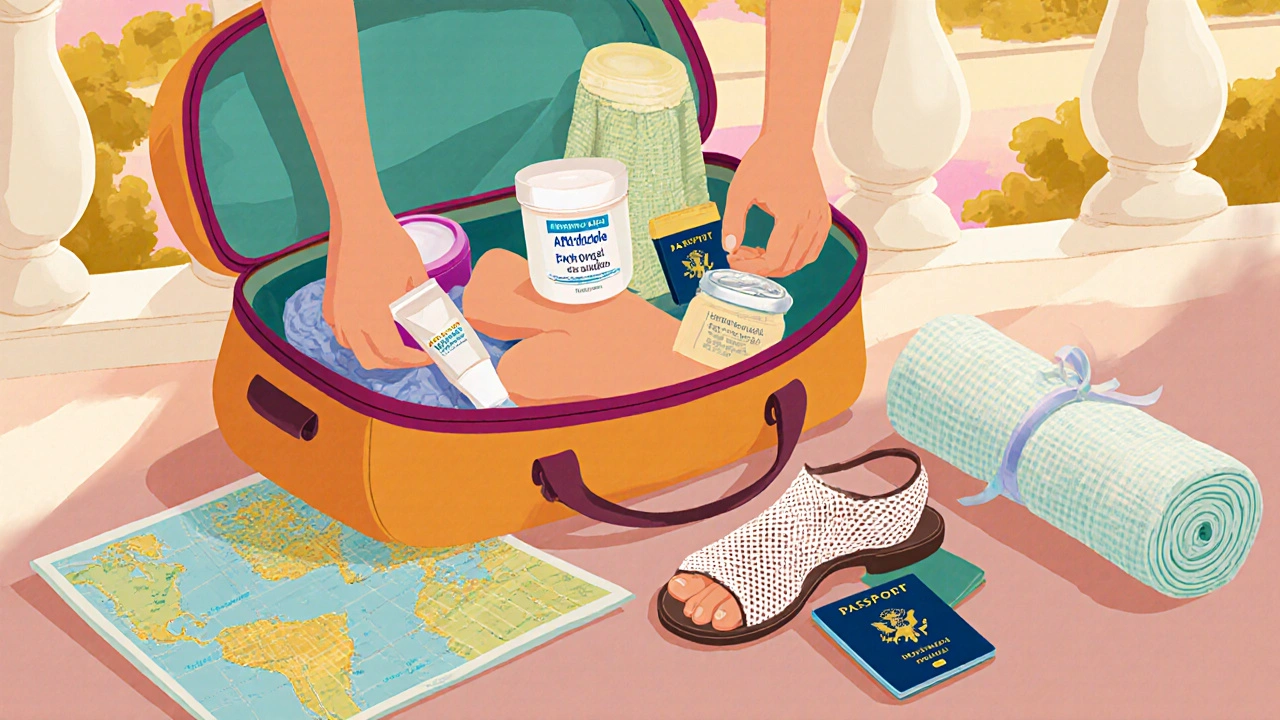Ringworm Risk Calculator for Travelers
Travel Risk Assessment
Answer a few questions to determine your risk level for ringworm infection during your travels.
Your Risk Assessment
Prevention Tips for Your Risk Level
Heading abroad is exciting, but skin infections can quickly turn an adventure into a nightmare. One of the most common culprits, especially in warm climates and communal settings, is Ringworm, a fungal skin infection caused by dermatophyte fungi that thrive on keratinized tissue like skin, hair, and nails. While it isn’t life‑threatening, the itchy, ring‑shaped rash can ruin a trip and spread to fellow travelers. Below is a practical, step‑by‑step guide to ringworm prevention that anyone can follow, from packing the right gear to cleaning up after a day of exploration.
Understand the Enemy: Who’s Behind Ringworm?
Most travelers encounter two main groups of fungi:
- Trichophyton species that love the warm, moist environment of feet and groin (think athlete’s foot that jumps to other body parts).
- Microsporum fungi that favor hair and scalp but can also infect the body.
Both thrive in public showers, locker rooms, and even hotel linens. Knowing their preferences helps you target the right preventative steps.
Pre‑Trip Planning: The First Line of Defense
Preparation starts long before you board the plane. Here’s a checklist you can copy into your notes app:
- Pack antifungal essentials. A small tube of over‑the‑counter (OTC) topical cream containing clotrimazole or terbinafine, plus a single‑dose oral antifungal (e.g., terbinafine 250mg) if you have a prescription for high‑risk trips.
- Choose breathable footwear. Opt for sandals or shoes made of mesh that let moisture escape. Pair them with moisture‑wicking socks (merino wool is ideal).
- Bring a portable foot‑drying kit. A compact microfiber towel and a travel‑size foot powder keep your feet dry after showers.
- Research local hygiene standards. Some destinations have limited clean‑water supplies; plan for disposable wipes or a handheld sanitizer.
These steps embody a concept known as Personal hygiene the daily habits that reduce pathogen exposure. When you make hygiene a habit, you lower the odds of picking up ringworm.
On‑The‑Ground Tactics: Daily Habits That Block Infection
Once you’re on the road, the battle continues. Integrate these habits into your routine:
- Keep feet dry. After any water exposure, wipe your toes and the spaces between them. Apply foot powder to absorb residual moisture.
- Avoid walking barefoot in communal areas. Use flip‑flops in dorm showers, public pools, and gym locker rooms. This simple barrier stops the fungi from contacting your skin.
- Wear loose, cotton‑blend clothing. Tight synthetic fabrics trap sweat, creating a perfect breeding ground for dermatophytes.
- Sanitize personal items. Wipe down yoga mats, bike seats, and any shared equipment with an alcohol‑based sanitizer before use.
- Inspect skin daily. A quick mirror check each evening can catch early signs-small red patches that widen into rings-before they spread.
These actions rely on the principle of Footwear hygiene keeping shoes and socks clean and moisture‑free. Rotate shoes whenever possible; let them air out for at least 24hours between wears.

When You Find a Rash: Early Intervention Saves the Day
If you notice a suspicious spot, act fast:
- Clean the area with mild soap and water.
- Pat dry-no rubbing.
- Apply a thin layer of your OTC antifungal cream, covering a margin of healthy skin around the lesion.
- Continue treatment for at least two weeks after the rash disappears to ensure the fungus is fully eradicated.
For larger or painful lesions, or if the rash spreads despite topical treatment, consult a local clinician. They may prescribe an oral antifungal, which works systemically to stop the fungus from growing.
Topical vs. Oral Antifungals: Quick Comparison for Travelers
| Aspect | Topical Cream/Gel | Oral Tablet |
|---|---|---|
| Speed of symptom relief | Visible reduction in itching within 2-3 days | Often faster systemic control, noticeable within 1-2 days |
| Duration of treatment | 2-4 weeks (continue 2 weeks after clearance) | 1-2 weeks, depending on severity |
| Side‑effect profile | Local irritation or redness | Possible liver enzyme elevation, GI upset |
| Convenience while traveling | Small tube fits in any bag | Requires prescription, may need pharmacy visit |
| Effectiveness against resistant strains | Effective for most common dermatophytes | Better for stubborn or widespread infections |
Most low‑risk travelers can stay safe with topical agents alone. High‑risk itineraries-such as backpacking through humid tropical regions with frequent hostel stays-might justify having an oral option on hand.
Special Situations: Children, Elderly, and Immunocompromised Travelers
These groups face higher infection rates because their skin barrier or immune response may be weaker.
- Children. Pack kid‑friendly antifungal wipes and teach them to wear flip‑flops in every shared shower.
- Elderly. Moisturize thin skin daily; dry cracks can become entry points for fungi.
- Immunocompromised. Discuss prophylactic oral antifungal therapy with a doctor before departure.
These considerations align with the broader concept of Immunity support maintaining a healthy immune system through nutrition, sleep, and stress management. Adequate sleep, balanced meals, and staying hydrated all contribute to a stronger defense against opportunistic infections like ringworm.

Post‑Trip Checklist: Keep the Home Front Clean
Even after you’ve returned, the risk isn’t over. Follow these steps to protect family members:
- Launder all clothing and towels in hot water (≥60°C) and dry on high heat.
- Disinfect luggage interiors with an alcohol wipe.
- Vacuum shoes and let them air out for a full day before re‑wearing.
- Monitor skin for any delayed rash for up to four weeks.
These actions prevent the fungi from establishing a foothold back home, a phenomenon known as fomite transmission the spread of pathogens via inanimate objects.
Quick Takeaways
- Carry an OTC antifungal cream and, if possible, a prescribed oral option for high‑risk trips.
- Keep feet dry, wear flip‑flops in communal areas, and choose breathable footwear.
- Inspect skin daily; treat any rash immediately with appropriate antifungal medication.
- Follow a post‑trip cleaning routine to avoid bringing the fungus home.
- Tailor prevention to vulnerable groups-children, elderly, and immunocompromised travelers need extra care.
Frequently Asked Questions
Can ringworm be caught from swimming pools?
Yes. The warm, moist environment of public pools and hot tubs can harbor dermatophyte fungi, especially around the pool deck and changing rooms. Wearing water‑resistant sandals and showering immediately afterward reduces the risk.
How long does it take for an OTC cream to clear a ringworm infection?
Most people see itching and redness subside within 7‑10 days, but the fungus may linger. Continue applying the cream for at least two weeks after the rash disappears to ensure complete eradication.
Is it safe to share towels while traveling?
Sharing towels is a major risk factor for fomite transmission. Always use your own towel or bring a quick‑dry microfiber towel that you can wash daily. If you must share, wipe the surface with a disinfectant wipe first.
Do oral antifungals require a prescription in most countries?
Yes. Oral agents like terbinafine or itraconazole are prescription‑only in most regions because they can affect liver function. If you anticipate needing them, arrange a prescription before you travel.
Can ringworm affect the scalp during travel?
Absolutely. Scalp ringworm, caused mainly by Microsporum species, can spread via hats, hairbrushes, or close contact. Use a gentle antifungal shampoo if you notice scaling on the scalp.

